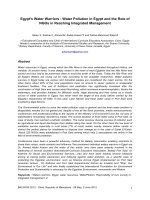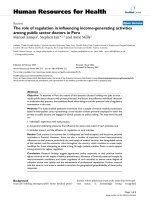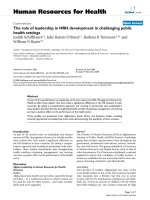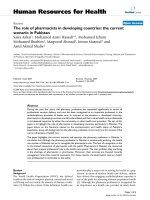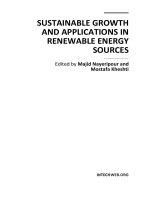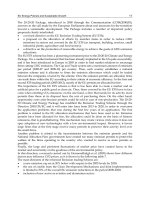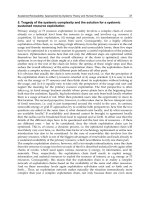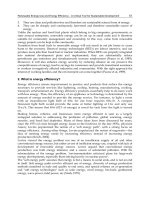role of hydrogen in renewable energy era
Bạn đang xem bản rút gọn của tài liệu. Xem và tải ngay bản đầy đủ của tài liệu tại đây (165.29 KB, 12 trang )
Role of hydrogen in renewable energy era
Rally to cover earth surface by renewable energy parks.
Hydrogen is major inevitable tool ON THE EARTH, not only for global earth energy transition, but also
for new more effective global energy evolution model ON THE EARTH.
1/ Global renewable energy transition is absolutely serious feasible scientific concept.
First of all, need to remind again that nature renewable energy source capacity power on earth is more
hundreds times than the power of all world human activities in 2020y in average.
Renewable energy sources on earth are not toys of joking, they are really more hundreds times than the
need to power all the human demands at current human rate at 2020y. It is feasible, but not for lazy
people just waiting to receive renewable energy without acting. Because of colossal of earth renewable
energy, renewable energy transition is not only for ecology, but also for money.
Need to cover earth surface/parts of earth surface by renewable energy parks. "Cover parts of earth
surface" sounds difficultly, but it is quite feasible and even easy, because renewable energy parks can be
easy very large sized. In a preliminary analysis, it shows that if people want, then they can cover entire
earth land surface by renewable energy parks in less 40 years.
Without affords to cover parts of earth surface by renewable energy parks, no renewable energy
transition is feasible.
Cover earth surface/parts of earth surface by renewable energy parks, means :
1.1/ Gradually try to fill suitable areas by renewable energy parks. In land, in rivers, in oceans.
1.2/ Convert world current cities architectures into new renewable energy friendly city architectures,
which more comfortably harness city renewable energy in resident home rooftops, in future rooftops of all
roads and pavements. At this time, all cities roads/pavements miss large amounts of renewable energy
above road rooftops.
1.3/ Convert agricultural farms into agrivoltaic zones to harness solar energy in sunny areas .
In lot of current large agricultural farms in sunny areas, plants take very small amount of solar energy, so
substantial solar energy is lost in form of heat.
Convert agricultural farms into workshops, which harness solar energy in workshops rooftops, then can
use part of solar electricity for agricultural LED lamps for plants. Today plants become to depend on
fertilizes + water + LED lights more than depending on soils. Modern farms may not need soils and sun
light, but need agricultural LED light + water + fertilizers.
2/ State critical energy supply safety level :
In cases of global/regional economic crisis, state energy supply abilities must be capable to supply enough
energy for :
+ Electricity/energy for resident warming at minimal level
+ Electricity/energy for key agriculture at minimal level
+ Electricity for resident houses uses at minimal level
+ Electricity/energy for crucial industrial spheres at minimal activity level
+ Electricity/energy for crucial transport traffic at minimal activity level.
It is state critical energy supply safety level.
It is impossible for every states to guarantee energy supply safety capacity for fully working all activities
and industries at full power.
But in almost all countries, even in some very cold european countries, if (1.2/) and (1.3/) are normal
realized, then (1.2/) + (1.3/) and/or with very little (1.1/) + basic nocomplicated hydrogen infrastructures
quite enough guarantee to achieve state critical energy supply safety level.
Any states should guarantee their state critical energy supply safety levels, which are feasible achieved by
(1.2/) + (1.3/) + basic nocomplicated hydrogen infrastructures.
3/ Which artificial energy distributing models are better in earth conditions ? Artificial
direct energy distributing model, or artificial fuel energy distributing model. Which is
better ?
Artificial direct energy distributing model : we transfer directly energy from energy sources to
consuming devices at live energy consuming time. We use batteries (for example in battery cars) to
receive energy from direct energy sources, and battery mobility devices must always stick to energy gates
when transferring energy. We are using artificial direct energy distributing model in the world this time.
Artificial fuel energy distributing model : we do not transfer direct energy to consuming processes, but we
transfer artificial fuels to energy consuming processes. Hydrogen is a type of artificial fuels in artificial
fuel energy distributing model.
There are 3 crucial bad features of artificial direct energy distributing model :
3.1/ Energy latency causes energy loss.
Energy latency between the live power of energy supplying and live power of energy demanding causes
energy loss. Every time, when energy latency rises, then energy loss rises too. For example, at the
moment t0, the energy supplying gives power of 10 energy units, and the energy demanding receives
power of 10 energy units. Then, at the next moment t1, the energy demanding needs only 5 energy units,
but the energy supplying can not successfully trigger the change in energy demand immediately, so only
after some short time, the energy supplying triggers changes and will give 5 energy units instead of 10
energy units. We say : energy latency happens.
In real life, energy latency happens frequently, and causes energy loss.
3.2/ Inevitable "double recharge cycles" of mobility devices in artificial direct energy distributing
systems.
Double recharge cycles decrease energy efficiency of mobility devices.
Because of intermittency between energy supplying sources and energy demanding mobility devices,
mobility devices very often CAN NOT BE CHARGED DIRECTLY FROM THE ENERGY SUPPLY
SOURCES. For example, it is very often that renewable energy charges some stationary batteries of
charging stations, then stationary batteries charge device batteries of mobility devices (battery cars). In
these cases, we call that mobility devices fall in double recharge cycles. When estimate energy efficiency
of mobility devices, from the point of last users, people often wrong think that energy efficiency of
mobility devices is about 65% (efficiency of lithium batteries in real life noideal application conditions).
But when fall in double recharge cycles, real energy efficiency of mobility devices is only 65%x65% ≈
42.2%, because there are 2 recharging in every cycles.
Even if batteries can be fully recharged in near zero seconds, then battery mobility devices (battery cars)
will often fall in double recharge cycles too.
Example : A solar energy park has power rate 1Mw, can give total 8 Mwh electricity in total 8 sunny
hours. You have a fleet of battery cars, which need totally 8Mwh electricity for 1 operating day. Every
your battery cars have holy grail ability to be full charged 0%->100% in near 0 seconds.
If you want to charge your fleet of battery cars in quick charging mode 1 hour, then you need total power
rate supply 8Mw, but your solar energy park has power rate only 1Mw, need additional 7 Mw power rate
from other sources. Today reality is that they just get additional 7 Mw power rate from coal energy
stations.
If you decide to use bigger energy power park, for example a solar energy park 8Mw, then your big solar
energy park 8Mw need only 1h to full charge your fleet of battery cars (your fleet of battery cars need
totally 8 Mwh for working). Then in other 7h of sunny times, the sun still works, and your big energy
power park charges some stationary batteries, which then charge your battery cars/other battery cars in
other times. -> Your battery cars/other battery cars fall in double recharge cycles.
3.3/ Charging time, and requirements of direct connecting devices to energy sources are some
contributors for economic recession.
In artificial direct energy distributing systems, energy demanding devices must always stick to energy
sources, and always need to sticks batteries to energy sources in long charging time durations. These 2
factors of course are some kinds of contributors to economic recession.
If study carefully, then it is obvious that economic loss of these 2 factors is substantial.
3.4/ Nature uses fuel energy distributing models everywhere in earth, in planets, in universe, in nature.
All nature creatures do not receive energy directly from energy sources. All nature creatures receive
energy through renewable fuels. No places for direct energy distributing models in nature. But
everywhere fuel energy distributing models in nature. We see the checked result : efficient nature energy
distributing model !
So the nature hints that artificial fuel energy distributing model is very good for all activities on earth.
Hydrogen energy model, in fact, is artificial fuel energy distributing model (with hydrogen is artificial
fuel).
4/ Hydrogen energy model is very good artificial energy distributing model in earth
conditions, not only for renewable energy sources, but also for future super high energy
sources.
Hydrogen energy model can help to deal with colossal amounts of renewable energy/clean energy
Hydrogen energy model avoids 3 above flaws (3.1/) (3.2/) (3.3/) of direct energy distributing models.
Especially the flaws (3.1/) and (3.3/) are substantial.
5/ Basic components of hydrogen infrastructures are quite simple and cheap.
Hydrogen technology is progressing. But the world can expand hydrogen model globally right now based
on current most basic technologies, instead of halt hydrogen infrastructure development process to wait
for new coming technologies. Current basic existing hydrogen technologies quite enough allow to build
efficient working hydrogen infrastructures. Then future new coming hydrogen technologies will be
gradually added to improve.
It means that need to build the following basic simple components in hydrogen energy models :
5.1/ Hydrogen storage :
Standard compressed hydrogen tanks/canisters 300 bar – 700 bar are well proved variant of efficient
energy storage.
Compressed hydrogen reinforcing skeleton tanks, which have inside/outside reinforcing skeletons, will
allow to make tanks wall to be thinner but stronger and more steadily. Thus reinforcing skeleton tanks
300bar-700bar are very lightweight but very steadily and can be flexible sized as small bottle size or
40feet container size or size of big ships. Hydrogen reinforcing skeleton tanks 300 bar-700 bar already
guarantee safe storage and enough energy onboard for all following applications :
+ small hydrogen cars, motorcycles, human sized robots.
+ big hydrogen vehicles
+ trains
+ ships
+ planes. (Planes more effectively use liquid hydrogen. Compressed hydrogen reinforcing skeleton tanks
700bar can supply enough energy onboard for various commercial planes applications, they are not
optimal solution, but they are simple working solution. ).
+ stationary energy storage for seasons. For example, a yard with tens of compressed hydrogen
reinforcing skeleton tanks 700bar can power social communes for months.
+ Private home and garden energy storage
Compressed hydrogen reinforcing skeleton tanks/balloons 300bar-700bar need to be main hydrogen
energy storage variant in all general purposed hydrogen applications at this time of 2021y.
Test in pilot projects : If any doubt rise, then just make reinforcing skeleton tanks 700+ bar to testing in
appropriate pilot projects. These hydrogen reinforcing skeleton tanks 700 bars will obviously show that
they supply quite enough necessary energy in all above applications, even thought tanks can be not very
compact sized, but not very big uncomfortable sized.
5.2/ Decentralized nets of electrolysing hydrogen filling stations with electric cables:
Decentralized hydrogen production onsite is good model. It means that from the clean/renewable/other
energy source, should connect through electric cables to many places of consumers, in where to build
many small distributed electrolysing hydrogen filling stations, instead of just connect to 1 place to build
only 1 very big electrolysing hydrogen filling station. Especially when hydrogen pipelines are temporary
difficult stuffs at 2021y, and demand sources are distributed in various places. Of course, need build
electric lines, need invest more on electric grids.
Electrolysing hydrogen filling stations should be begun in basic variant (electrolysers + compressors +
compressed hydrogen reinforcing skeleton tanks 350bar – 700 bar). Then time by time possible add more
hydrogen reinforcing skeleton tanks 350 bar – 700 bar for more storage. These electrolysing hydrogen
filling stations are quite simple and noexpensive. Try to ignore liquid hydrogen.
Encourage renewable/clean energy projects owners to build decentralized nets of electrolysing filling
stations with electric cables. Because It help them to decrease energy curtailments.
5.3/ Centralized nets of hydrogen filling stations with hydrogen pipelines :
Centralized hydrogen productions need hydrogen pipelines for effective transferring. It means that from a
centralized big hydrogen production plant, should built hydrogen pipelines to many hydrogen filling
stations. Of course, need to build hydrogen pipelines, need to invest more on hydrogen pipeline grids.
Hydrogen filling stations should be begun in basic variant (compressors + compressed hydrogen
reinforcing skeleton tanks 350bar – 700 bar). Then time by time possible add more hydrogen reinforcing
skeleton tanks 350 bar – 700 bar for more storage. These hydrogen filling stations with hydrogen
pipeline are quite simple and noexpensive. Try to ignore liquid hydrogen.
Encourage hydrogen production projects owners to build centralized nets of hydrogen filling stations with
hydrogen pipelines. Because It helps them to sell more hydrogen.
5.4/ Hydrogen fuel cell vehicles are centerpieces to allow off grid electrification every where and off grid
electrifying houses/facilities every where.
It is always very comfortable and fantastic to build electrifying houses/facilities everywhere in your local
areas without connecting to electrical grids. Off grid electrifying houses/facilities are really kind of dream
freedom! Extensible hydrogen fuel cell cars 350-700 bars and/or standard hydrogen fuel cell cars 350-700
bars are centerpieces for flexible electrification everywhere.
Extensible hydrogen fuel cell cars 700 bars are standard hydrogen fuel cell cars, but with little bigger
hydrogen tanks (of with extensible hydrogen tanks).
How the model works : hydrogen fuel cell vehicles go to local hydrogen filling stations (in (5.1/) and
(5.2/) ) to load compressed hydrogen 700 bar, then come back to houses to power houses by integrated
hydrogen fuel cells of cars. One today popular passenger hydrogen fuel cell car with full integrated
hydrogen tanks 700 bar can power a standard resident house for many days and even for week.
Extensible hydrogen fuel cell cars can power off grid houses for month (with houses warming function
included too).
Certified hydrogen forklifts 700 bar, which are reinforcing skeleton tanks 700 bars on wheels
with/without integrated hydrogen fuel cells, are noexpensive, and can power off grid houses and various
off grid facilities for months or even years per one full hydrogen loading. Haul certified hydrogen
forklifts 700 bars to some local hydrogen filling stations to load compressed hydrogen 700 bar, then haul
back hydrogen forklifts to power off grid houses and facilities. Try to ignore liquid hydrogen.
Conclusion : Simple components (5.1/) + (5.2/) + (5.3/) + hydrogen fuel cell vehicles (hydrogen
cars/extensible hydrogen cars/hydrogen forklifts) create effective working artificial fuel (H2) energy
distributing system, like the ones nature has.
These artificial fuel (H2) energy distributing systems ( (5.1/) + (5.2/) + (5.3/) + (5.4/) ) allow electrifying
everywhere. They can complement/replace/combine/cooperate current world conventional artificial direct
energy distributing systems.
Lets see whether time can prove again that the artificial fuel (H2) energy distributing systems are more
efficient than today world conventional artificial direct energy distributing systems in earth conditions,
even thought nature once has proved same.
Test in pilot facilities :
+ build 1 basic electrolysing hydrogen filling station (electrolyser + compressor + reinforcing skeleton
tanks 350-700 bar). Then build electrical cable to connect electrolysing hydrogen filling station to
clean/renewable energy plant.
+ build 1 basic hydrogen filling station (compressor + reinforcing skeleton tanks 350-700 bars). Then
build hydrogen pipeline to connect hydrogen filling station to hydrogen production plant.
+ pick a hydrogen fuel cell car. Build a simple hydrogen forklift.
Then use hydrogen fuel cell car/hydrogen forklift to power off grid house/facility to convince that
hydrogen fuel cell car and hydrogen forklift can power off grid houses/facility very well and efficiently.
6/ Use hydrogen infrastructures (components (5.1/)+(5.2/)+(5.3/)+(5.4/) to stimulate and
create hydrogen general purposed markets :
6.1/ Expansible nets of hydrogen filling stations (5.2/)+(5.3/) (electrolysing hydrogen filling stations
and/or pipeline hydrogen filling stations) are comfortable for hydrogen vehicles. Can sell hydrogen.
We will see in real test (8.1/) (8.2/), that passenger hydrogen cars are not less energy efficient than
passenger battery cars. But it is true only in nets of hydrogen filling stations (5.2/)+(5.3/).
6.2/ Off grid electrifying houses/facilities are necessary and effective in various cases in societies.
With hydrogen fuel cell cars/extensible hydrogen fuel cell cars/hydrogen forklifts , nets of hydrogen
filling stations are comfortable to support off grid electrifying houses/facilities. Can sell hydrogen.
6.3/ Hydrogen filling stations (electrolysing hydrogen filling stations and/or pipeline hydrogen filling
stations) can connect to local natural gas pipeline systems to push renewable hydrogen to mix with natural
gases for heating. Can sell hydrogen.
Firing hydrogen for heating should be temporary solution only. Because hydrogen firing create additional
nitrogen oxides. But hydrogen firing together with natural gases can reduce carbon dioxide emissions.
Besides hydrogen and gases mixtures firing induces less temperatures than pure hydrogen firing, so
induces significant less nitrogen oxides.
Some critical people blame that hydrogen firing for heating is less energy efficient because lose energy to
produce hydrogen then lose energy to fire hydrogen. It is not true in the current model of nets of
electrolysing hydrogen filling stations. In practices, electrolysing hydrogen filling stations often connects
to renewable energy sources through intelligent energy management systems. Intelligent energy
management systems always delivery energy from renewable energy sources to most suitable direct
demand sources in first priorities. Then when nowhere to directly delivery energy in various moments,
then intelligent energy management systems delivery energy from renewable energy sources to
electrolysing hydrogen filling stations. It is often that hydrogen from electrolysing hydrogen filling
stations is hydrogen from surplus energy.
It is true that should take renewable hydrogen instead of fossil fuel hydrogen for heating.
When retrofit current natural gases pipelines to transfer 100% hydrogen, then most effective hydrogen
household warming is household hydrogen fuel cells. Today hydrogen fuel cells have electric efficiency
55+%, and energy loss in form of heat. If hydrogen fuel cells will be used for home heating, than heating
efficiency can be 95%. But in practices, hydrogen fuel cells will be often used simultaneously for
electricity and home heating at same times, so overall energy efficiency can be near 100%. Household
hydrogen fuel cells are becoming cheaper every years.
6.4/ Hydrogen filling stations can be equipped more with additional stationary fuel cells, so that
hydrogen filling stations can charge battery vehicles too. Can sell hydrogen.
Of course, stationary batteries are more energy efficient than stationary hydrogen fuel cells at this time.
But typical inherent flaws of batteries, low battery capacity, expensive battery scalability, battery self
discharge, strong dependence of batteries on ambient temperatures, .., can not allow to use stationary
batteries in various cases. In these cases, stationary hydrogen fuel cells are good alternatives.
6.5/ Hydrogen filling stations can be expanded with more compressed hydrogen tanks and additional
hydrogen fuel cells to become really seasonal electricity storage stations. Can sell hydrogen.
6.6/ Extreme hydrogen demanding facilities always need DEDICATED HYDROGEN PIPELINES TO
BIG HYDROGEN PRODUCTION PLANTS AND/OR DEDICATED ELECTRIC CABLES TO
ELECTRIC PLANTS.
The crucial big misunderstanding is that people often wait for expanding general hydrogen infrastructures
before building extreme hydrogen demanding facilities.
Extreme hydrogen demanding facilities, for example big metallurgical plants, big hydrogen hubs for
planes, big hydrogen hubs for ships, big hydrogen fertilizer plants, … , need dedicated hydrogen pipelines
to various hydrogen production plants, and/or dedicated electric cables to electricity plants. It means that
every extreme hydrogen demanding facilities must care following additional tasks :
+ Need to build dedicated hydrogen pipelines from extreme hydrogen demanding facilities to some
hydrogen production plants.
+ And/or need to build electric cables from extreme hydrogen demanding facilities to electricity plants,
then put electrolysers at extreme hydrogen demanding facilities to produce hydrogen onsite.
7/ Use hydrogen infrastructures (components (5.1/)+(5.2/)+(5.3/)+(5.4/) to fund to support
and to encourage numerous private solar household rooftop investors and numerous local
private renewable energy investors.
Many governments encourage citizens to install solar rooftops panels. Solar rooftops installing are very
lucrative projects with noexpensive investments for citizens. Colossal numbers of citizens and private
small investors worldwide are ready to install solar rooftop panels/small renewable energy objects.
But unfortunately, local governments can not manage this kind of very big numbers of distributed small
intermittent clean energy sources. The consequence is that local governments can not always pay for
every watts from solar rooftops panels, and solar rooftops panels very often throw away valuable energy.
Obviously a kind of energy loss.
Popular today solution is that solar rooftop panels owners to buy additional separated energy storage
systems. Practice shows that the model works, but not efficiently works. Private separated small energy
storage systems are expensive, so many people still not to install solar rooftop panels in their sunny areas
because of expensive private energy storage batteries. Besides, by buying private separated small energy
storage systems (for example batteries), societies can not get energy interoperability, so societies can save
some energy loss by avoiding energy transmission, but lose other profits because of no energy
interoperability. For example, my solar rooftop panels give more power than I need, but my neighbors
need more power then they have. I should share my surplus power for them for money. The other popular
example : I have money to install solar rooftop panels and battery storage for my home/garden full
rooftop surface, but I personally do not have needs to use big amount of energy, so I just install few solar
rooftop panels enough for my needs only, while my neighbors beg for electricity. Need mechanism to
achieve energy interoperability.
Local nets of electrolysing hydrogen filling stations are good mechanism to manage numerous local solar
rooftop panels energy sources to step by step achieve ideal energy interoperability. Private investors just
install their solar rooftops panels, then sell electricity through grids to local nets of electrolysing hydrogen
filling stations, without investing in expensive private separated batteries. It will be observed : when local
areas have much surplus solar rooftop panels energy to grids, then new local electrolysing hydrogen
filling stations will be added (electrolysing stations are quite simple and cheap). By that way, some
balances and energy interoperability will be achieved time by time. Local nets of electrolysing hydrogen
filling stations sell hydrogen, for example as shown in (6.1/) (6.2/) (6.3/) (6.4/) (6.5/) (6.6/), so local
nets of electrolysing hydrogen filling stations significantly help to pay for local solar rooftop panels
energy.
8/ What are most energy efficient passenger vehicles in era of renewable energy systems,
hydrogen cars or battery cars ? .
The short clearly answer is that : number of hydrogen cars must be bigger than number of battery cars.
Personal battery cars are good. But personal hydrogen cars are even better than battery cars for economic
gains and for ecology gains.
The optimal transport model is that need to use personal hydrogen vehicles together with personal battery
vehicles.
Concretized pilot tests to finally clarify that personal hydrogen fuel cell cars are not less energy efficient
than personal battery cars in almost all real life use cases in over the the world :
8.1/ Using electricity from only renewable energy sources for battery cars and for hydrogen cars
Pilot facilities for battery car test (using only renewable energy):
+ 1 renewable energy source.
+ 1 battery car, for example the Tesla battery car.
+ 1 battery charging station. And 1 stationary battery. (As known, renewable energy is intermittent, and
intermittency between general battery car working schedule and renewable energy generating schedule,
so stationary battery is a 'must have').
+ 1 electric cable to connect the charging station to renewable energy source.
Working : The battery car randomly go to this charging station to be charged.
because of the intermittency of renewable energy and the car working schedule and the renewable energy
generating schedule, the battery car is often not charged directly from renewable energy source, but is
often charged from stationary battery at this charging station. We say : this battery car often falls in
double recharge cycles.
Energy efficiency of stationary battery = 65% in real life no ideal conditions.
Energy efficiency of battery of this battery car is 65% in real life no ideal conditions.
-> Energy efficiency of this battery car in double recharge cycles : 65% x 65% = 42.2%.
Pilot facilities for hydrogen car test (using only renewable energy) :
+ 1 renewable energy source.
+ 1 hydrogen fuel cell battery car, for example the Toyota mirai 2021y.
+ 1 modular electrolyser Thysenkrupp. 1 compressor. 1 hydrogen reinforcing skeleton tank 350-700
bar.
+ 1 electric cable to connect the this hydrogen station to renewable energy source.
Working process : The hydrogen car randomly goes to the hydrogen charging station to load hydrogen.
The electrolysing hydrogen filling station can flexible choose schedule to run the electrolyser in tandem
with renewable energy generating schedule. Electrolyser makes hydrogen onsite. Compressor compresses
hydrogen to 350 bar, then stores in tanks.
Energy efficiency of electrolyser Thyssenkrupp : 80%
Energy efficiency of compressing hydrogen to 350bar : 95%.
Energy efficiency of hydrogen fuel cells in the Toyota mirai 2021y is about : 55+% .
-> Energy efficiency of this hydrogen car Toyota mirai 2021y in this case : 80%x95%x55% = 41.8% .
We see that, renewable energy sources often work 6 hours per day (24h), so battery car in renewable
energy systems very often falls in double recharge cycles (not always, but very often), so in renewable
energy systems, this battery car has practically same energy efficiency as the hydrogen car Toyota mirai
2021y, energy efficiencies 42.2% vs 41.8% .
Conclusion : battery cars and hydrogen cars are very often practically same energy efficient in
renewable energy systems.
8.2/ Using electricity from fossil fuels for battery car and hydrogen car.
Pilot facilities for battery car test (using electricity from fossil fuels):
+ 1 fossil fuel electricity generating plant.
+ 1 battery car, for example the Tesla battery car.
+ 1 electric cable to connect the charging station to fossil fuel electricity generating plant.
Working : The fossil fuel electricity generating plant uses some fossil fuels to generate electricity, and
transfers electricity to the battery charging station. The battery car randomly goes to this charging station
to be charged.
Energy efficiency of fossil fuel electricity generating plant = 35% in real life no ideal conditions.
Energy efficiency of battery of this battery car is 65% in real life no ideal conditions.
-> Energy efficiency of this battery car this case : 35% x 65% = 22.8%.
Pilot facilities for hydrogen car test (using only energy from fossil fuels) :
+ 1 chemical fossil fuel hydrogen production plant. (Hydrogen is produced from fossil fuels, for example
in methane conversion process).
+ 1 hydrogen fuel cell battery car, for example the Toyota mirai 2021y.
+ 1 compressor. 1 hydrogen reinforcing skeleton tank 350-700 bar.
+ 1 hydrogen pipeline to connect the this hydrogen station to the chemical fossil fuel hydrogen
production plant.
Working process : The chemical fossil fuel hydrogen production plant produce fossil fuel hydrogen, then
directly transfer hydrogen via hydrogen pipeline to this hydrogen station. At the hydrogen station, the
compressor compresses hydrogen to 700bar to store hydrogen in reinforcing skeleton tank 700 bar.
The hydrogen car randomly go to the hydrogen station to load compressed hydrogen 700bar.
Energy efficiency of chemical fossil fuel hydrogen production plant : 75%
Energy efficiency of compressing hydrogen to 700bar : 90%.
Energy efficiency of hydrogen fuel cells in the Toyota mirai 2021y is about : 55+% .
-> Energy efficiency of this hydrogen car Toyota mirai 2021y in this case : 75%x90%x55% = 37.1% .
We see that : battery car is remarkable less energy efficient than hydrogen car when using energy from
fossil fuels, energy efficiencies 22.8% vs 37.1% .
Conclusion : when using energy from fossil fuels sources, hydrogen car (using fossil fuel hydrogen)
clearly wins against battery car by energy efficiency.
8.3/ Passenger battery cars vs passenger hydrogen cars game is over : AT LEAST, PASSENGER
HYDROGEN CARS ARE NOT LESS ENERGY EFFICIENT THAN PASSENGER BATTERY CARS
IN REAL LIFE USE CASES. It is very mild word. In fact, if care all real factors (3.1/) (3.2/) (3.3/)
(3.4/), then passenger battery cars clearly lose substantial total economic gains against passenger
hydrogen cars. But lets accept mild personal transport transitions : it is useful to use less passenger
battery cars together with more passenger hydrogen cars in society for total economic gains and ecology
stimulus.
If any doubts rise, then just let these easy repeated direct objective pilot tests (8.1/) and (8.2/) confirm the
advantages of passenger hydrogen cars.
8.4/ Worldwide myths about lied disadvantages of passenger hydrogen cars because of following reasons
:
- Passenger hydrogen cars were always analyzed and compared without hydrogen infrastructures or with
wrong hydrogen infrastructures : there are no any electrolysing hydrogen filling stations, there are no any
hydrogen filling stations with hydrogen pipelines.
- People often compare personal battery cars, which often hiddenly use electricity from fossil fuels, with
passenger hydrogen cars on renewable energy. It leads to wrong conclusions.
- All current liquid hydrogen filling stations of fossil fuel coalitions for passenger hydrogen cars are
absolutely bad wrong. But worldwide silly experts often assess and compare passenger hydrogen cars in
infrastructures of the current wrong liquid hydrogen filling stations of fossil fuel coalitions.
- Hydrogen cars manufactures did not achieve success in past time, because hydrogen cars manufactures
did not invest in right hydrogen filling stations. There are no electrolysing hydrogen filling stations, and
no hydrogen filling stations with pipeline at 2021y. Battery cars manufacture Tesla invested billions usd
to achieve their own more than 30 000 Tesla charging stations worldwide at 2021y. Besides, almost all
current hydrogen filling stations now are liquid hydrogen station, and are involved in monopole of fossil
fuel coalitions, which do not want that cheap fossil fuel hydrogen will affect their gasoline business. They
set hydrogen prices to equal gasoline prices.
8.5/ When hydrogen cars will have going cost equal to going cost of battery cars ?
- When create electrolysing hydrogen filling stations, then hydrogen cars will very often have going cost
nearly equal to going cost of battery cars in renewable energy systems. (refer to (8.1/) ).
But in fact, all battery cars today always regularly use fossil fuel electricity. So we see that battery cars
today have small going cost against hydrogen cars with renewable energy. As describe above, it is not
because battery cars really always more energy efficient than hydrogen cars in renewable energy systems.
But it is because that battery cars regularly hiddenly use fossil fuel electricity.
- When create hydrogen filling stations with hydrogen pipelines to hydrogen production plants, then
hydrogen cars will have significantly less going cost than going cost of battery cars. (refer to (8.2/) ).
9/ Fossil fuel hydrogen is inherently fossil fuel !
9.1/ Fossil fuel hydrogen is the universal optimal efficient method for converting all kinds of fossil fuels
to electricity.
World conventional method uses thermal electricity plants to convert fossil fuels to electricity with energy
efficiency about 35%. And by using conventional approach, we fall into the artificial direct energy
distributing system, which has 3 bad flaws (3.1/) (3.2/) (3.3/) . Total economic loss of these 3 flaws is
very substantial.
The fossil fuel hydrogen electrifying approach : instead of firing fossil fuels in thermal electricity plants,
firstly convert fossil fuels to hydrogen, then transfer hydrogen via pipelines to hydrogen filling stations,
then compress hydrogen at hydrogen filling stations to store hydrogen in tanks 350bars. Then hydrogen
fuel cells take hydrogen from hydrogen filling station to generate electricity. As shown in (8.2/), the total
efficiency is : 75%x90%*55% = 37.1%. We get total efficiency little better than conventional method.
But we fall in artificial fuel energy distributing system, which avoids 3 bad flaws (3.1/) (3.2/) (3.3/). Total
economic gain of avoiding these 3 flaws is very substantial.
Fossil fuel hydrogen is the comfortable universal representative of all fossil fuels. There are some types of
fossil fuel cells for various different fossil fuels. It is not comfortable. Good to convert all fossil fuels to
hydrogen, so that deal with only hydrogen fuel cells, instead of dealing with various complicated fossil
fuel cells.
9.2/ Big question on plans of importing fossil fuel hydrogen : Because fossil fuel hydrogen is fossil fuel,
so in many cases better to just import fossil fuels themself then to produce fossil fuel hydrogen onsite at
destination places, instead of transporting fossil fuel hydrogen to destination places.
In the same way, need to convert all kinds of biofuels to hydrogen for electricity, instead of directly firing
biofuels for electricity in thermal electricity plants. And hydrogen can be comfortable universal
representative of all biofuels.
9.3/ Fossil fuel hydrogen for electricity is better way than thermal fossil fuel electricity plants.
Fossil fuel hydrogen is 100% fossil fuel, it is not ecology. The world does not like fossil fuels, but If the
world reluctant accepts to still reluctant use fossil fuels for electricity in few tens years more, then NEED
TO USE FOSSIL FUEL HYDROGEN FOR ELECTRICITY, INSTEAD OF FOSSIL FUEL
ELECTRICITY FROM THERMAL ELECTRICITY PLANTS (FOSSIL FUEL ELECTRICITY
PLANTS). In this approach, the meaning of fossil fuel hydrogen for ecology is that fossil fuel hydrogen
helps to use less fossil fuels to achieve same amount of electricity, because the fossil fuel hydrogen
electrifying approach has little more energy efficiency and substantial economic gains (3.1/) (3.2/)(3.3/).
